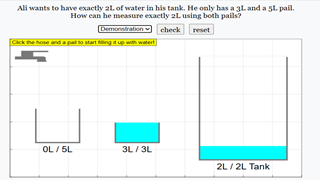toFixed(0)
Credits
['kangRui', 'meiYoke', 'looKang']
Credits
['kangRui', 'meiYoke', 'looKang']
Credits
['']
 |
| iwant2study.org |
Thinking Aloud: Fill the Tank – Interactive Math Puzzle
Introduction
The Thinking Aloud: Fill the Tank interactive simulation challenges users to solve a classic water-pouring problem using logical reasoning and experimentation. In this scenario, Jia Hao needs to measure exactly 4L of water using only a 5L pail and a 3L pail. The user must figure out the correct sequence of actions to achieve the goal.
This simulation, available at Thinking Aloud: Fill the Tank, encourages users to develop problem-solving skills and understand the principles behind measuring volume with limited tools.
How to Play
- Click the tap to fill one of the pails with water.
- Click a pail to pour water into another pail or into the target tank.
- Continue the process until exactly 4L of water is collected in the tank.
- Click Check to verify your solution.
- Click Reset to start over.
The interface includes:
- A 5L pail and a 3L pail.
- A 4L target tank.
- A Scenario selector for different challenges.
- Buttons for checking the solution and resetting the simulation.
The Mathematical Thinking Behind It
This problem is a classic example of using the greatest common divisor (GCD) to measure specific volumes. The 5L and 3L pails can only measure amounts that are multiples of GCD(5,3) = 1L, meaning they can measure any quantity that is a sum or difference of these values.
Solution to Fill 4L:
- Fill the 3L pail completely from the tap.
- Pour the 3L into the 5L pail.
- Refill the 3L pail from the tap.
- Pour 2L from the 3L pail into the 5L pail (which now holds 5L and is full).
- The remaining 1L in the 3L pail is the key.
- Empty the 5L pail completely.
- Transfer the 1L from the 3L pail to the 5L pail.
- Refill the 3L pail again and pour it into the 5L pail.
- Now, the 5L pail contains exactly 4L, which can be poured into the target tank.
This problem demonstrates modular arithmetic and logical deduction, making it a great exercise in computational thinking.
Learning Outcomes
- Develop problem-solving skills by experimenting with different sequences.
- Apply number theory concepts like GCD and modular arithmetic in a real-world scenario.
- Encourage logical reasoning through trial and error.
- Enhance mathematical intuition with hands-on exploration.
This interactive aligns well with the heuristics approach in problem-solving often emphasized in mathematics education.
Conclusion
The Thinking Aloud: Fill the Tank simulation is an engaging way to explore problem-solving with water measurement. It serves as an excellent classroom tool for students to practice logical reasoning, sequencing, and number properties. Try it out at iwant2study.org and challenge yourself to find the most efficient way to fill the tank!
Sample Learning Goals
[text]
For Teachers
[text]
Research
[text]
Video
[text]
Version:
- http://weelookang.blogspot.sg/2016/02/vector-addition-b-c-model-with.html improved version with joseph chua's inputs
- http://weelookang.blogspot.sg/2014/10/vector-addition-model.html original simulation by lookang
Other Resources
[text]
end faq
{accordionfaq faqid=accordion4 faqclass="lightnessfaq defaulticon headerbackground headerborder contentbackground contentborder round5"}
- Details
- Written by Loo Kang Wee
- Parent Category: Interactive Resources
- Category: Mathematics
- Hits: 1255









